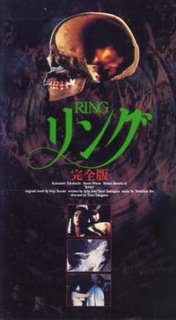RING: KANZENBAN
(TV Movie, 1995, Japan)
a.k.a. 'Ring: The Complete Edition'
The Ring Phenomenon
I’ve said it before, but I’m grateful that my love of horror films were re-energised by Japanese films. Ring (1998) kick-started a new cycle of effective horror films in the East, and started me off on a journey into Asian cinema both new and old.
Ring or Ringu is not just a film, but a very potent story rich with possiblities. Which is why, each time it’s remade, it’s different. This happens all the time with remakes, but it astonishes me how often Ring has been remade in only ten years.
Before Gore Verbinski’s American version The Ring (2002), the original book had already been filmed four times in the East, there had already been two TV series and three movie sequels! Talk about lagging behind! This is before we get into the rip-offs.
Ring: Kanzenban
The very first filmed version of Ring was a TV movie made in 1995, three years before the hit Japanese movie was released! Ring: Kanzenban was shown on Fuji TV as a movie of the week, then later released in a soft-porn version on videotape (of course). I’m confused as to whether ‘Kanzenban’ (which translates as ‘The Complete Edition’) refers to the TV movie being ‘complete’ and faithful to the novel (which it pretty much is), or to the complete, uncut sexed-up version on video.
I’ve seen very scathing reviews which lead me to think this was low budget, but it’s really quite impressive, with a wide range of location filming and some cleverly faked flashback footage and an intricate attempt at the cursed video itself.
It starts with a very familiar death scene, a young girl alone at home, dying in a locked room. (But in this version, there’s no phone ringing). A news reporter, Asakawa, witnesses a motorcyclist keel over and die and realises that four mysterious deaths have happened all at the same time. He soon traces the four victims’ movements back to a remote holiday lodge in the mountains, where he learns they have all watched a videotape exactly a week before they died. He finds and watches the tape and soon wishes he hadn’t…
This version of Ring is quite faithful to the plot of the novel. The problem isn’t the budget, but the cliched approach. It’s fascinating to watch one of the greatest ever ghost stories being treated like a bad horror movie. Over-the-top camerawork, flashing lights, and exaggerated acting all demonstrate perfectly how not to film Ring. Instead of subtlety, it relies on young, attractive stars and female nudity to get attention. From the Friday the 13th school of horror, where young women dress only in t-shirts or nothing at all. The TV version has nudity and an attempted rape, apparently the video release version has more graphic sex scenes as well.
But it’s not scary.
It works as a story, a mystery, a race against time. But imagine Ring not being a horror film!
We should thank Ring: Kanzenban for at least generating sufficient interest in getting the novel filmed properly. (At this time, the novel still wasn’t a hit). It’s script was also influential on the interpretations that followed – again, Meikle’s book explains this all in detail.
For Ring fans, it’s interesting to see familiar scenes being filmed differently – particularly the playing of the cursed video – very close to the description of the book, the images seem to invade the whole room, not just the person watching.
Sadako’s death scene involves rape and a different murder weapon. Each version I’ve seen, she gets raped or attacked by a different person and killed in a different way. But, the iconic well in this version is square! Sadako herself is rendered far from scary, by being young, beautiful and naked, (there’s even frequent nude scenes in the TV version).
Interesting, not essential and far from available. Ring: Kanzenban was only released on VHS and VideoCD in the East (see various covers, above). It’s not been officially subtitled anywhere and wasn’t released on DVD.




Very interesting... I had been interested in Ju On: The Grudge and found out there were 6 movies involved. I had already seen Ringu and The Ring (US) but was fascinated with Ringu. I then looked up all the sequels and found them all including this one. Which intrigues me. I want to watch this but I need the subs :( Maybe they'll release it one day but without the nudity
ReplyDeleteI believe the version on TV had less nudity, so there should be a version of it out there.
ReplyDelete